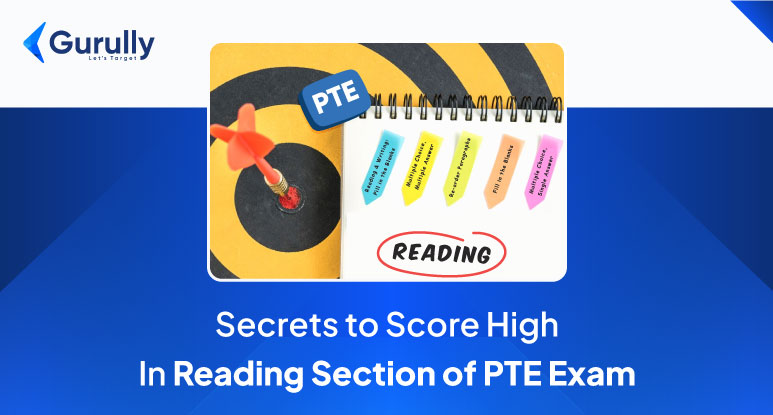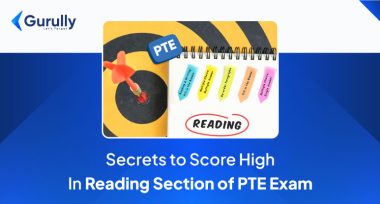Are you preparing for PTE Exam? If yes, then you must not miss this segment. You might be very well aware of the exam format, but preparing strategically is the secret to score high in exams. PTE is divided into four sections: Speaking, Writing, Reading & Listening. Out of these 4 sections Reading section is the most challenging. So here are PTE Reading tips that will help you in clearing this section easily.
The PTE Reading section can be a daunting challenge for many test-takers. With its diverse question types and time constraints, it requires a strategic approach to achieve your target score. This blog post will explore essential tips and techniques to help you excel in the PTE Reading section and boost your overall score.
Question-Types Of PTE Reading Section:
- Reading & Writing: Fill in the blanks
- Multiple-choice, Multiple Answers
- Reorder Paragraphs
- Reading: Fill in the blanks
- Multiple choice, Single answer
PTE Reading Tips For- Reading & Writing: Fill in the blanks
This question type will be presented with text containing gaps. Below the text, you will find a list of options. Select the appropriate word or phrase from the list to complete each gap in the text. Your reading and writing skills will be tested.
- Time is of the Essence: Allocate approximately 2-3 minutes per “Fill in the Blanks” question to balance comprehension and speed.
- Focus on the Question: Begin by carefully reading the question to understand its core and identify relevant keywords.
- Eliminate Incorrect Options: Quickly discard wrong answers to streamline the selection process.
- Consider All Possibilities: Given the multiple-choice format, meticulously evaluate each option before making a decision.
Practice Tips For – Multiple-choice, Multiple Answers
The Multiple-Choice, Multiple Answers question type in the PTE Reading section requires test-takers to select all correct options from a list of potential answers. Here, you’ll need to dig deeper into the passage to find all the different pieces of information that answer the question.
- Understand the Story: Figure out what the passage is about. The answers are usually hidden there!
- Spot the Keywords: Look for important words. They’ll guide you to the right answer.
- Watch Out for Tricky Words: Words like “always,” “never,” and “all” can sometimes be misleading.
- Don’t Skip Questions: Even if you’re unsure, guess! There’s no penalty for wrong answers.
- Eliminate Wrong Options: Cross out answers that don’t fit. This makes it easier to pick the right ones.
Practice Tips For – Reorder Paragraphs
Reorder Paragraphs directly assess your ability to deconstruct a text and analyze how individual paragraphs contribute to the overall meaning. Allocate approximately 2-3 minutes per question to balance accuracy and speed.
- Identify the Beginning: Start by pinpointing the opening paragraph, which typically introduces the main topic.
- Look for Connections: Identify transitional words and phrases that signal the logical progression of ideas.
- Apply Logical Sequencing: Arrange paragraphs based on cause and effect, chronological order, or argument development.
Practice Tips For -Reading: Fill in the blanks:
It tests how well you know words and how well you understand a passage’s meaning by filling in the blanks with the right words. To do well, you need a big vocabulary and the ability to pick the word that fits best with the other words around it.
- Get the Big Picture: Quickly scan the text to understand its main idea. This will help you see how the missing pieces fit together.
- Clues are Everywhere: Pay close attention to the words around the blank. They often hint at the kind of word you need (noun, verb, adjective, etc.).
- Don’t Be Afraid to Guess: There’s no penalty for wrong answers, so try your best even if you’re unsure.
- Focus on Word Order: Look at the words before and after the blank to figure out the missing word’s role in the sentence.
- Synonyms are Your Friends: The missing word is often similar in meaning to another word in the text.
Practice Tips For – Multiple choice, Single answer
This question type measures your comprehension of a reading passage by asking you to select the single answer choice that best captures the main idea or a specific detail from the text.
- Understand the Whole Story: Read the entire passage carefully to grasp its main idea and supporting details.
- Spot the Clues: Look for keywords in both the question and the answer choices that link back to the passage.
- Weigh Your Options: Carefully consider each answer choice, eliminating those that don’t match the passage of the question.
PTE Reading Section’s Exam Strategy
- Skim and Scan: Quickly grasp the overall text structure and pinpoint crucial information. This focused approach ensures you absorb only essential details.
- Double Check the Question: Reading the question twice enhances understanding and prevents overlooking vital clues.
- Identify Key Words: Pinpointing keywords within the text directs your focus and accelerates the search for relevant information.
- Eliminate Incorrect Options: When faced with multiple-choice questions, systematically rule out incorrect answers to increase your chances of selecting the correct choice.
- Practice Regularly: Consistent practice with PTE-specific materials sharpens your reading skills, improves time management, and boosts overall performance.
With respect to these PTE Reading tips, you can also practice question-wise on Gurully. Dive deep into specific question types to identify areas needing improvement and solidify your understanding. Our full-length mock tests provide a realistic exam simulation, allowing you to assess your overall performance. Moreover, our AI-powered practice tests offer real-time feedback.
We also provide a prediction file outlining potential question types to aid in exam prediction. Incorporating these resources into your study plan will give you the confidence and skills needed to excel in the PTE Reading section.
Conclusion:
Conquering the Reading section demands strategic PTE preparation and efficient time management. Understanding the various question types, implementing effective techniques like skimming, scanning, and keyword identification, and practicing regularly can significantly enhance your reading speed and accuracy.
Focus on developing a strong vocabulary, improving grammar, and honing your ability to understand different text structures. With dedication and the right approach, you can achieve your desired PTE reading score.
Also Read:
- PTE Summarize Written Text Template With Predictive Questions & Answers to Score High
- Top 10 Free PTE Practice Websites To Help You Score 79+
- PTE Write From Dictation Tips & Tricks to Score Higher







